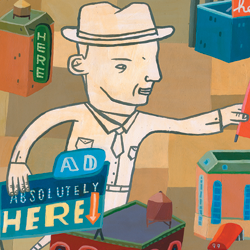Last-minute shipments are sometimes inevitable in the trade show world. Here are your options when it comes to fast-tracking freight. By Candy Adams

n a perfect world, all trade show freight would hit the road with a day to spare for inclement weather, mechanical failures, or human error, thus allowing you to select the least expensive, most reliable way to get it to the show floor on time and intact. Sadly, exhibit managers don't live in a perfect world. More often than not, some situation, person, or vendor throws a monkey wrench in the middle of your plans and you're left scrambling for a backup plan to get back on track.
So what do you do when you have a shipment that has to get to the show, and it's still sitting on the company dock? If you can't find a replacement in the show city, get organized. Create a manifest containing all of the items that need to be shipped, including their packaging (e.g., boxes, crates, rolling audiovisual cases, graphics tubes), and dimensions. Record each individual package's weight, along with the total weight of your shipment.
Also figure out exactly how much time you have before the shipment needs to be on the show floor. How many days (or hours) are left before "last minute" becomes "too late"? And, if you're shipping internationally, get the required paperwork in order. You'll have to take all this information into account when it comes to the next step: deciding which of the following options best suits your needs.
 Don't Ship It
Don't Ship It
Before jumping through hoops to make a last-minute shipment happen, take a look at what you're shipping and determine if it is really mission critical. Ask yourself the following questions: What happens if I don't send it, or if I send it, and it doesn't get there in time? What are the best- and worst-case scenarios? By answering these questions and weighing the pros and cons of your decisions before running to a FedEx Office in a panic, not only will you save your sanity, but also you might save a lot of cash. Here, then, are some work arounds (broken down by item) to help you sidestep a last-minute shipping showdown.
 Marketing Collateral.
Marketing Collateral. When it comes to collateral literature, it doesn't matter how many boxes of the stuff you ship to a show, you usually end up with leftovers. So before sending hundreds of pounds of paper to the convention center, ask yourself if you can hand carry a sufficient amount to the show and then print the remaining quantity needed at a quick-print shop (e.g., FedEx Office, Office Depot, etc.) when you arrive. In fact, this option is so common that some quick-print shops near convention centers even offer free delivery to the trade show venue's lobby.
If you don't feel comfortable taking your chances with such a shop, consider shipping less collateral to the show to begin with. For example, you could skip the hard-copy collateral in favor of distributing business cards with URLs that link to product info on your company's website. Or you can purchase a color printer in the show city and print literature on demand in your exhibit. Another option is to send collateral as a follow-up tool used by your sales staff, versus an in-booth, on-site handout given to every show attendee that enters your exhibit.
 Exhibit Graphics. If you need graphics printed at the last minute, you can contact the show's general services contractor (GSC). It likely has a local graphics-production facility that can print, deliver, and install them before the trade show opens, eliminating the last-minute shipping charges — and avoiding material-handling fees you'd be charged once those graphics arrived. Depending on the time frame, this may also reduce or eliminate rush production charges, since GSCs are typically set up for last-minute printing.
Exhibit Graphics. If you need graphics printed at the last minute, you can contact the show's general services contractor (GSC). It likely has a local graphics-production facility that can print, deliver, and install them before the trade show opens, eliminating the last-minute shipping charges — and avoiding material-handling fees you'd be charged once those graphics arrived. Depending on the time frame, this may also reduce or eliminate rush production charges, since GSCs are typically set up for last-minute printing.
If your graphics are straightforward (with simple logos and typography, not a lot of imagery, etc.), you can use a quick-print shop. With this route, call the shop in advance to inquire about its capabilities and time frames for production, and confirm that it can provide the proper substrate, lamination, and mounting media (such as tape or hook-and-loop fastener).
 Carpet.
Carpet. Exhibit carpet is such a utilitarian component that its arrival in your booth space is relatively easy to take for granted. But I once had to rent carpet on site. Of course, I couldn't get the exact color I needed to match the carpet that did make it safe and sound, so I had to improvise and order two 10-foot strips in a complimentary color to position on each end of my exhibit. It was cheaper than renting carpet for the entire exhibit, and it allowed us to get the more complex center area of the booth built while awaiting delivery of our end strips. So before you shell out the dough to overnight those two rolls of flooring you forgot to pack in your initial shipment, determine whether renting is a viable — and potentially cheaper — option.
 Exhibit Components.
Exhibit Components. If you're missing an item needed to complete your exhibit installation (such as a pole, bracket, or shelf) check to see if there is a local exhibit house that carries the same brand of components that can either sell or loan you the part you need. And talk with your on-site installation crew before you resort to sending a last-minute shipment, as more often than not it will have an innovative fix or two on hand.
 Use a Small-Package Carrier
Use a Small-Package Carrier
If you decide that your shipment has to go, consider a small-package carrier (such as UPS, FedEx, DHL Worldwide, etc.). Consult your shipping department to help you figure out which carrier is the best pick based on what you need to ship and the carrier's delivery schedule. Unfortunately, there are no one-size-fits-all answers when it comes to what the different carriers will accept, how they will ship your freight, or how long they will take to deliver your freight to its destination.
For example, let's say you decide to use a small-package carrier to ship three 42-pound cartons (for a total shipment weight of 126 pounds) using the selected carrier's "no-later-than-10 a.m." delivery option. Here are four things that could happen, all of which affect your delivery time and material-handling costs:
 Scenario One. Your cartons (labeled "1 of 3," "2 of 3," and "3 of 3" on the carrier's preprinted labels) are separated during shipment and arrive at the show on three different trucks (unless you palletize them or strap them together). Your material-handling costs will increase if your three packages aren't consolidated because each separate package will be written up as a separate shipment at the 200- to 300-pound material-handling minimum charge, which will be reflected in your drayage invoice.
Scenario One. Your cartons (labeled "1 of 3," "2 of 3," and "3 of 3" on the carrier's preprinted labels) are separated during shipment and arrive at the show on three different trucks (unless you palletize them or strap them together). Your material-handling costs will increase if your three packages aren't consolidated because each separate package will be written up as a separate shipment at the 200- to 300-pound material-handling minimum charge, which will be reflected in your drayage invoice.
In other words, instead of your three 42-pound boxes counting as one shipment totaling 126 pounds — and costing you one 200-pound minimum charge — your packages could end up costing you three 200- to 300-pound minimum charges. That's up to 900 pounds worth of handling charges for a 126-pound shipment.
If you're missing an item needed to complete your exhibit installation (such as a pole, bracket, or shelf), check to see if there is a local exhibit house that carries the same brand.
 Scenario Two.
Scenario Two. Your selected small-package carrier arrives at 9:59 a.m., and the freight is shoveled off the back of the trailer onto a special, dedicated dock just for small-package carriers — with only one signature for the entire load.
With this scenario, you lose your ability to accurately track your freight's actual arrival time on show site. And when you try to determine the location of your items, the carrier will say it delivered the shipment on time, and the GSC will only be able to tell you it's not yet showing up in its system. And since the GSC isn't going to let you pick through a pile of boxes to find your packages, you're basically back to square one — missing an item that you need for the show despite your last-ditch efforts.
 Scenario Three.
Scenario Three. Your delivery is delayed because the most recent shipments to arrive at the dock go to the end of the pile to be processed by the GSC's material-handling personnel. That process can take anywhere from a few hours to a full day, depending on the time the freight arrived, the amount of small-package freight being processed, and the number of material-handling personnel assigned to the task. So even if your shipment arrives at, say, 10 a.m., it might not be processed and delivered to your exhibit space until the end of the day.
 Scenario Four.
Scenario Four. Your inbound freight requires additional documentation because small-package carriers do not provide a single document recognized by the GSC as an inbound bill of lading. So each piece of freight has to be weighed (generally on a portable scale) and recorded on a GSC-approved form before it will be delivered to your booth space. Since your package(s) won't be delivered until the substitute document confirming the receipt of your freight and its respective weight is created, your delivery will be delayed.
Given these worst-case scenarios, a less expensive — and more timely — option may be to ship to a small-package carrier's office in the show city, assuming your freight isn't so unwieldy that you can't handle it alone. Plus, if you select email notification when you place your shipping order, you will receive an email confirming delivery of your shipment. Then, you can simply pick up the package yourself as soon as it arrives. This option avoids hundreds of dollars in material-handling fees (as long as you can hand carry your freight into the exhibit hall), sidesteps the wait time to get your package(s) at the convention center, and works especially well for small and lightweight shipments.
 Use a Trade Show Transportation Carrier
Use a Trade Show Transportation Carrier
These carriers specialize in airfreight or expedited trade show freight that is familiar with handling "I-need-it-yesterday" shipments. If you have an existing relationship with an airfreight carrier, now is the time to call and ask for help. As a vendor reminded me early in my trade show career, show freight isn't time sensitive, it's time critical, and no one understands this better than a carrier dedicated to quick shipments and on-time deliveries.
When you call your shipping agent, provide him or her with all the available details (i.e., the weight and size of your shipment, and type of packaging, as well as the drop-dead time it needs to arrive at the destination). Your agent will then have to do some research to figure out which airfreight option would work best considering your circumstances.
Depending on the amount of time you have to get your shipment to its destination, you may want to first consider ground transportation. And you have two options: An airfreight/expedited carrier or van line.
Ground transportation will likely take longer, but if you're using a van line, you might be able to request a pair of drivers for the vehicle. The amount of miles one driver can cover in a day is regulated, but by having two drivers, your freight can cover twice as many miles per day.
The plus to using airfreight, an expedited truck, or a van line is that the freight will arrive on a single bill of lading; therefore, you will only be charged material handling for the actual weight of your entire shipment, rounded up to the nearest hundred pounds, and not for individual pieces that may not arrive at the same time via small-package carriers with multiple minimum weights.
Time it Right
Regardless of the mode of transportation you choose, don't forget to factor in extra time, since even if your freight arrives right on schedule in the show city, more time will be required to get it from the airport or truck terminal to the show venue, through the marshaling yard's material-handling process, to the dock, and then delivered to your booth space. And depending on when your freight arrives during show setup, your truck driver could find himself or herself at the end of a line at the marshaling yard awaiting assignment of a dock space near your exhibit — and your diminishing window of time will shrink faster than exhibit-marketing budgets during a recession.
If you're lucky enough to get your shipment to the show before that window slams shut, take a breather and give yourself a pat on the back. Then, review the events that led up to the last-minute shipment, and learn from the experience. After all, if you can learn from your mistakes — or the mistakes of whomever put you in this shipping snafu — you might be able to avoid them in the future.




 n a perfect world, all trade show freight would hit the road with a day to spare for inclement weather, mechanical failures, or human error, thus allowing you to select the least expensive, most reliable way to get it to the show floor on time and intact. Sadly, exhibit managers don't live in a perfect world. More often than not, some situation, person, or vendor throws a monkey wrench in the middle of your plans and you're left scrambling for a backup plan to get back on track.
n a perfect world, all trade show freight would hit the road with a day to spare for inclement weather, mechanical failures, or human error, thus allowing you to select the least expensive, most reliable way to get it to the show floor on time and intact. Sadly, exhibit managers don't live in a perfect world. More often than not, some situation, person, or vendor throws a monkey wrench in the middle of your plans and you're left scrambling for a backup plan to get back on track. 





